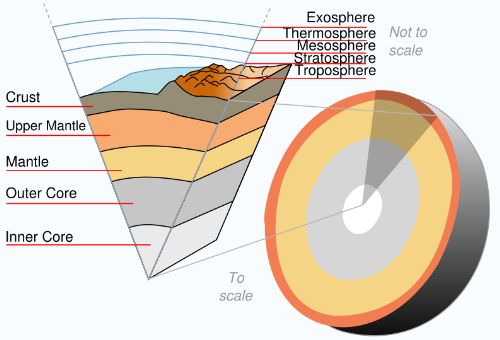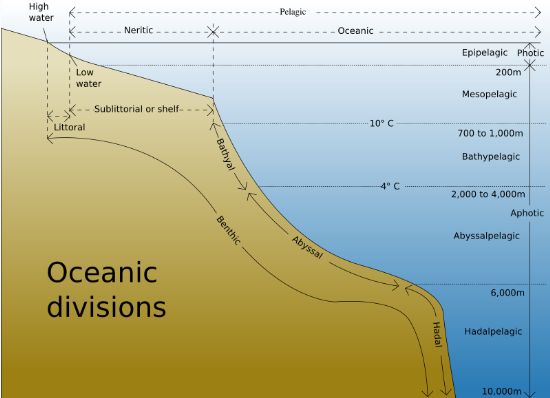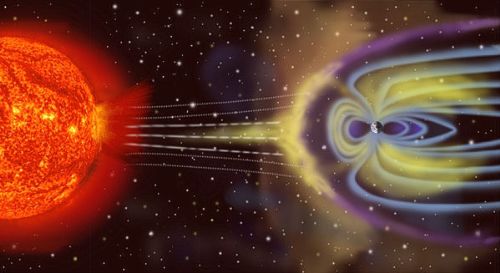by Larry
April, 2008Our Multi-Layered Earth, From Inside Out
Starting with the deepest, here are the principal layers of our active planet, plus an extra "icing" region that surrounds all the others:
The Land Inner Core
Inner Core
Earth's inner core is a roughly solid ball of nickel-iron (primarily iron) alloy, about 70% the size of the moon, suspended in the center of a molten outer core. It's radius is 1220 km or about 760 miles. The temperature is estimated at 5000-6000°C (over 9000°F) and to be as hot as the sun's surface. Recently it has been learned that in puzzling ways it is not as totally solid as its great mass and surrounding pressures would cause one to expect. Rather, it now is wondered if the inner core itself has layers, crystalline formations, or areas within its structure where there are extensive liquid-filled passages. As with most areas of frontier science where speculation must make up for a lack of direct observation, there are several theories about the precise nature of the inner core. It remains to a degree a realm of mystery. Outer Core The outer core surrounds the inner with a roughly 2200 km or 1370 miles thick molten region of nickel-iron alloy. Around 10% of the outer core is also sulphur and oxygen. The temperature here is not quite so hot as at the inner core and is estimated to be about 4500°C (8100°F). One might ask, then, why the outer core is liquid while the inner is solid. The answer seems to be that the gravitational pressure is much greater for the latter. The relative motion of the outer vs. the inner core is thought to generate Earth's magnetic field. Lower Mantle The lower mantle is a roughly 1140 km or 710 mile thick layer surrounding the outer core. Temperatures here range up to 4000°C (7200°F). The silicon, magnesium, oxygen, iron, calcium, and aluminum which compose this region are, whether pure or chemically mixed, in solid forms due to the intense pressure at these depths. Convection currents move the material of the layer at the rate of about an inch a year. Upper Mantle The upper mantle begins at a depth below the surface of roughly 30 km or 19 miles and is about 630 km or 390 miles thick. Its temperatures vary from about 500°C to 900°C (930-1650°F). The elements making up the lower mantle also are significant in the upper mantle layer, along with water and carbon. It is thought that substantial amounts of atmospheric gases were originally released from the upper mantle. As is apparent from volcanic activity, seafloor spreading, and the gradual shifting of the tectonic plates that rest on it, the upper mantle is more turbulent than the lower and has a greater impact on the surface. Crust
The Earth's crust is the 25-30 km or roughly 16-19 miles thick solid portion of the surface that rests tenuously on tectonic plates above the upper mantle. Although seeming most of the time quite permanent to transient beings going about their lives on its surface, the crust's total depth is but an insignificant fraction (about .5%) of our turbulent planet's radius, and its relative thickness has been compared to the skin of an apple. The crust's mercury readings vary from air temperature, farthest from Earth's center, to about 870°C (1600°F), at its depths, sufficient to melt rock. The crust is also, of course, one of the more fundamental layers for the likes of you, me, and all other living things in this part of the universe. And it is the last resting place for all who have gone before us, of whom or of which we now have some benefit in the form of the pressure-cooked remains of long past carboniferous life: peat, coal, natural gas, and petroleum, the burning of which allows us much greater ease and economic vitality today but, as if thereby we may have unleashed a curse, it is at the cost of freeing their ghostly carbon residues, likely causing us or our successors untold problems in years to come.
The Sea Hadeopelagic Zone
Hadeopelagic Zone
This "hellish ocean" layer is reserved for depths so great they occur only in deep sea trenches, roughly 6000 to 10,000 meters (20,000 to 33,300 feet) below the ocean surface. There is little detailed knowledge of this region. Pressures are intense, sometimes as great as 16,200 pounds per square inch. Manned exploration, even in the hardiest submarines, is rare. The Hadeopelagic Zone may be less well observed now than the moon. Most of what life exists here is thought to get its nutrition from chemicals prevalent around thermal vents. Abyssopelagic Zone The name of this layer means "bottomless ocean." While the bottomless description is inaccurate, the depths are profound, roughly 4000 to almost 6000 meters (around 13,300 feet to nearly 20,000 feet). The creatures here might appear alien to us, for instance those having quite large eyes in relation to their clear bodies, the only light in this region coming from the brief flashes of bioluminescent species. Some animals have adapted scoop-like mouths for sifting through the muck that settles at the bottom, such debris perhaps arriving only after lengthy downward drifts. Other denizens of these deeps include jellyfish, tube worms, and a few clams. Bathypelagic Zone Were one to descend from the surface, in this "midnight zone" she or he would first encounter a region completely devoid of sunlight. The depths here are from 1000 to almost 4000 meters (roughly 3300 to nearly 13,300 feet). The layer is virtually freezing cold. Most creatures here are rather small, only centimeters long, and conserve energy by adopting a "wait for it" food gathering strategy. Typical specimens are the bristlemouths, angler fish, swallower eels, and gulper eels. Exceptions to the "small is beautiful" adaptation in the bathypelagic zone are the giant squid, which sometimes will make an appearance here, or huge sperm whales that lie on the bottom pending the arrival of their giant squid prey. Mesopelagic Zone This middle zone, also termed the "twilight zone," lies beneath the shallower photic level and above the completely sunless layers. There is some light, though not sufficient for photosynthesis. This layer includes a thermocline, useful in submarine stealth tactics, with temperatures of over 20°C possible above it, while below it in the same layer they may be as low as around 4°C. The depth of this layer ranges from 200 to almost 1000 meters (roughly 660 to nearly 3300 feet). Typical fauna here include swordfish, squids, wolf eels, and cuttlefish. Epipelagic Zone
This surface or photic ocean layer is the shallowest of all the sea regions, extending only from the surface down to around 200 meters (about 660 feet). It is relatively well illuminated and so permits photosynthesis. Here there is the most abundant plant and animal aquatic life, including coral reefs and all their associated fauna and flora, the majority of shellfish, tuna, sharks, dolphinfish, many jellyfish, and most seafood for our tables. Temperatures here range from as high as about 36°C (97°F) to as low as around 20°C (68°F), except in the polar regions where near freezing mercury readings are found. This is one of the three layers (the others being the Earth's crust and the atmospheric troposphere) most favored by biosphere's life forms, including of course ourselves. And it is one of the regions of our planet under greatest assault by human activity as a result of: commercial overfishing; global warming (which affects some sea regions dramatically, as in the mid-Pacific or the Arctic); and pollution in general. Even without atmospheric changes secondary to our influences, transformations occurring within the epipelagic zone would be startling in themselves and have far-reaching consequences. As one example, coral reefs are greatly under stress. At current rates of decline most may have "died" or disappeared by 2050. Not only will their loss have huge effects on the global fishing and tourism industries, but the disappearance of these effective barriers against storm surges would be as significant for many tropical coastal areas as a breaching of levies was recently in New Orleans. The AirThis is the 8-16 km (roughly 5 to 10 miles) thick layer where all our weather occurs. It is thinnest at the poles and has its greatest depth at the Equator. It is the lowest level of Earth's enveloping gases and provides us with all our breathable atmosphere as well as air for commercial, military, or recreational air travel. On average, the comfortably breathable lower portion of this layer is limited to just a 4 km (about 2.5 miles) thick zone that does not even cover all of the Earth's crust. Hence many of our peaks rise well above this thin region. We can live and work at ease only in a slim zone that includes the very top portions of the Earth's crust and oceans plus the very bottom of the troposphere. To be generous, let us say this combined region is 5 km (about 3 miles) thick. When conditions are pleasant, Peri and I typically walk at least this far daily. One might look on the thickness of this zone in relation to the rest of our planet (.08%) as like the surface of a bubble of pond scum swelled to the size of Earth's surface, and we then would be like the invisible microbes living on its sheer translucent surface. As has been frequently remarked, this insubstantial realm, where we and most all other living things prevail, is vulnerable to but slight adverse changes that we may introduce. Over the span of homo sapiens' history and prehistory, roughly 150,000 years, it is only during the past 10 millennia, in the Holocene Epoch, that conditions have been favorable enough for the rise of civilizations. But the Holocene geological era is coming to an end. Before our eyes it is being replaced by a brave new globally warmer world, one in which (barring nuclear winter or an equivalent, as yet unforeseen disruption) the summer hue of Antarctica will be green. Stratosphere The stratosphere is that layer of our atmosphere above the troposphere. It extends upward from generally about 16 km (10 miles) to 50 km (31 miles) except over the poles where it starts at around 8 km (5 miles). This layer is warm above and cool below. Temperatures in the upper stratosphere can reach -3°C (27°F), while in the lower stratosphere they may drop to only -85°C (-121°F). The stratosphere contains an ozone layer, which helps protect plants and animals from intense radiation. The layer has been depleted in the last several decades by certain aerosols and other pollutants. This may be a factor in increased skin cancers and blindness among humans and in recent declines of amphibian numbers. Mesosphere This middle atmosphere layer lies at an elevation from the surface of about 50 km (31 miles) to 85 km (53 miles). Temperatures in the mesosphere can fall as low as -100°C (-146°F). Perhaps the most remarkable thing about this portion of our atmosphere is that, although millions of meteors a day (most fortunately quite small) hit our atmosphere on the way toward the land or sea portions of our planet, almost all burn up within the mesosphere, while many of the others are broken up there, the resulting smaller pieces usually doing little or no damage once they impact. Thermosphere This layer, literally meaning "heat sphere," lies at about 85 km (53 miles) to around 500 km (roughly 310 miles) altitude and is the main buffer between us and solar heat. Bursts of radiation from the sun may measure up to 15,000°C, but we are not fried by them because air in the thermosphere, though quite thin, is sufficient to absorb most all their energy. In the process, gas particles in the layer can get rather hot themselves, up to about 2500°C (4532°F). Oddly enough, air molecules are so dispersed there that an ordinary thermometer registers the thermosphere temperature as 0°C, and if one could expose an arm there, she or he would not even feel warm while surrounded by these thin super-heated gases. The layer is famous these days for the orbital presence in its upper levels of the International Space Station. It is also the layer in which aurora phenomena occur. The intense heat of the thermosphere creates the electrically charged ionosphere, off which our radio waves are bounced. Exosphere
Beyond the thermosphere, the exosphere, our atmosphere's outer or final region, is the layer in which outer space and Earth's air merge. Gas molecules there are even more dispersed than in the thermosphere. The exosphere altitude ranges from around 500 km (roughly 310 miles) to far out from the planet's surface, roughly 10,000 km (about 6200 miles). Air molecules in the exosphere are so far apart that there is little likelihood of their colliding. It is because the air is so thin there that the next lower layer absorbs most of the solar heat headed toward Earth.
The Force Magnetosphere
Magnetosphere
Earth's magnetic field surrounds and interpenetrates its layers. The zone of the field's influence is called the magnetosphere. It contains through magnetic and electrical forces free ions or electrons from the solar wind and Earth's ionosphere, preventing most of them from affecting Earth's multiple layers. The name magnetosphere is misleading, for its shape is hardly spherical. It extends outward roughly 70,000 km from the center of the Earth (10 to 12 Earth radii) on the sun side of the planet but tapers off on the side away from the sun, this tail extending then well beyond 200 Earth radii. There is a plasma of ions in the magnetosphere. These may be joined by electrons from light gases in the exosphere, in the process creating a "glow" of hot plasma clouds around the planet. NASA's IMAGE mission successfully sent back pictures of this phenomenon.
Primary Sources: The Weather Makers - How Man is Changing the Climate and What It Means for Life on Earth. Tim Flannery. Grove Press, New York, 2005 Wikipedia - The Free Encyclopedia Graphics in the public domain from Wikipedia Commons |